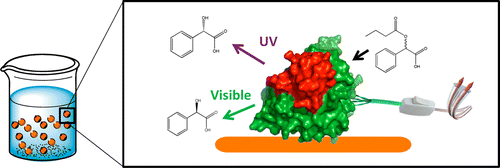A lipase was immobilized on transparent agarose microspheres and genetically engineered to specifically anchor photochromic molecules into its catalytic site. Several combinations of azobenzene and spiropyran groups were conjugated to cysteines introduced at different positions near the active center. Light modulated the catalytic properties of the resulting solid bioconjugates, and such modulation depended on both the nature of the photochromic compound and the anchoring position. Covalent anchoring of azobenzene derivatives to the residue 295 of the lipase 2 from Bacillus thermocathenolatus triggered lipase preference for the S isomer under UV light, whereas visible light promoted preference for the R isomer. Molecular dynamics simulations indicate that conjugating photochromic compounds into the catalytic cavity allows manipulating the steric hindrance and binding energy of the substrates, leading to an enantioselective molecular fit in certain cases. Using this approach, we report for the first time the control of enzyme properties using light in the solid phase.
